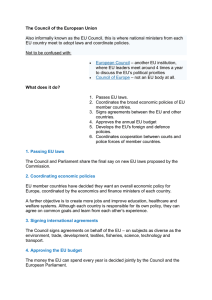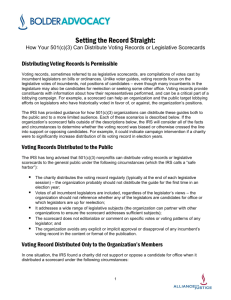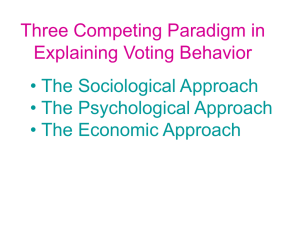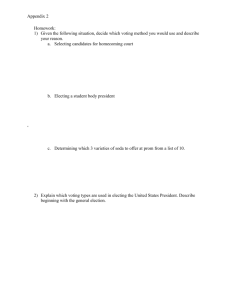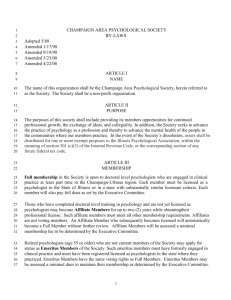Peter Ferdinand - University of Nottingham
advertisement
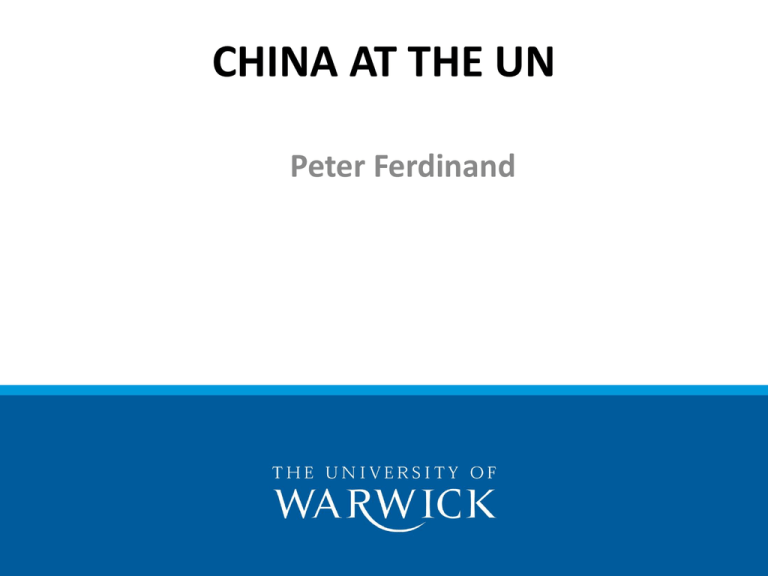
CHINA AT THE UN
Peter Ferdinand
Structure
• Significance of UN for China
• Voting record of China in UN General
Assembly
• China in UN Security Council
• China and reform of the UN
Significance of UN for China
• 2011 Sanya Declaration of BRICS states,
which reiterated their ‘strong commitment to
multilateral diplomacy with the United
Nations playing the central role in dealing
with global challenges and threats’.
• The UN is potentially an important factor in
the transition from a unipolar to (more of) a
multipolar one
• By enhancing the significance of the UN,
China also wants to enhance its own role in
global governance
And of China’s behaviour at the UN for our
understanding of Chinese foreign policy in
general
• ‘The United Nations General Assembly represents the
organized views of more governments on more subjects
than any periodic gathering in the world… Its agenda
always contains the unconquered difficulties of past
years and the new issues of recent weeks.’ (Gordenker)
• ‘The UN […] serves as the central platform from which
China seeks to project itself as a responsible power that
fulfils its obligations toward the international
community by respecting universal rules of
international conduct.’ (Odgaard)
China’s main objectives at the UN
1. Protecting sovereignty, autonomy and
independent decision-making
2. Maintaining geostrategic balance and
national security
3. Cultivating a favourable international image
and its status as a responsible great power
4. Promoting its economic and political
interests (Yang)
5. Steadfast adherence to absolute sovereignty
and preference for dialogue over force in
resolving conflicts
6. Conviction that Chapter VII actions must
have the consent of the countries against
whom they are directed
7. Support for government policies promoting
economic and social development over
human rights
8. Upholding and strengthening the role of
international law in international relations
(Odgaard)
Voting in the UN General Assembly
• General characteristics:
• 1974 and 2008 altogether 3384 issues put to the
vote, though states occasionally missed
individual votes. This divides into 2079 in the
period 1974-90 and 1305 in the period 19912008. On average there are between 60 and 150
such votes in any one year. Overall 511,292
votes were cast by individual states, whether
positive, negative or abstentions. Of these 83.7
per cent were ‘yes’, 4.6 per cent were ‘no’, and
11.7 per cent were abstentions.
UNGA Voting 1974-2008 (in percent)
Yes
Abstain
No
Brazil
88.8
10.3
1
China
88.1
9.1
2.8
India
85.2
10.8
4
USSR/Russia
75.1
16
8.9
S.Africa*
90.5
7.9
1.6
France
43.9
35.5
20.6
UK
41.8
32.7
25.4
US
20.2
23.6
56.2
General Assembly
83.7
11.7
4.6
UNGA voting of Pacific Asian States
Brunei*
Cambodia
China
Indonesia
Japan
Korea (North)**
Korea (South)**
Laos
Malaysia
Myanmar
Philippines
Singapore
Thailand
Vietnam
UK
USA
World
Yes
93.2
95.5
88.1
93.2
57.3
86.5
66.9
91.5
93.5
87.7
93.1
90.5
92.8
90.7
41.8
20.2
83.7
Abstain
5.5
3.8
9.1
4.4
33.1
7.7
27.6
5.8
5.1
10.8
5.9
9.0
6.7
5.4
32.7
23.6
11.7
No
1.3
0.7
2.8
2.4
9.6
5.8
5.5
2.7
1.5
1.5
1.0
0.5
0.6
3.9
25.4
56.2
4.6
Agreement Index Scores for Pacific
Asia & EU 12
Pacific
Asia
NE Asia
SE Asia
SE Asia +
China
EU 12
1974-90
83.82
1991-2008 1974-2008
83.22
83.59
67.56
91.61
90.74
68.18
93.09
92.07
67.80
92.19
91.26
74.49
91.51
81.05
Agreement Index Scores for BRICS
States
1974-9
1980-9
1990-3
1994-9
2000-8
BRICS
0.77
0.86
0.78
0.75
0.82
0.82
IBSA*
0.88
0.9
0.93
0.82
0.82
0.89
R & Ch.
0.84
0.85
0.69
0.7
0.84
0.83
P5
0.49
0.45
0.5
0.57
0.53
0.54
Fr., UK &
0.82
0.71
0.69
0.74
0.68
0.74
US
2009-11
AI Formula
AI = {MAX Y,N,A} – 0.5[(Y+N+A) – MAX{Y,N,A}]
Y+N+A
Where MAX(Y,N,A) represents the highest number of
particular kinds of votes within a given group for a
particular resolution, whether it is ‘yes’, ‘no’ or
‘abstain’. The range of possible final AI scores is
between 1 (perfect cohesion) and 0 (total lack of
cohesion, i.e. equal numbers of ‘yes’, ‘no’ and
‘abstain’ votes).
China-P5 IVC Voting Scores
China-France
ChinaUSSR/Russia
China-UK
China-US
1974-2008
60.16
82.53
1992-2008
62.66
80.73
55.78
29.3
58.91
23.39
Index of Voting Cohesion
(IVC)Formula
IVC = (f + 0.5g) x100
t
Where f denotes all the cases when two states vote
identically, g denotes the occasions when one of them
abstains, and t denotes the total number of votes that
both states cast
China in UNSC
• Promoting objective of creating favourable image as
responsible power
• China has contributed the most troops to UN peacekeeping operations of all P5 states
• Cast only 4 vetoes till 1999 (e.g. over Guatemala and
Macedonia which were moving towards recognition of
Taiwan), and not obstructive over Iraq
• Self-image as consistent supporter of developing countries
• Sees Russia as the most natural partner in SC?
• Has tended to let Russia take the lead on issues where
Chinese core interests are not involved, e.g. the Middle
East?
P5 Voting in UNSC 2000-12
Votes
N=796
Yes
Rate
Abstentio
ns
Rate
Vetoes
Rate
United
States
776
Russia
China
France
772
776
789
United
Kingdom
786
97.5%
97%
97.5%
99.1%
98.7%
9
17
16
7
10
1.1%
2.1%
2%
0.9%
1.3%
11
7
5
0
0
1.4%
0.9%
0.5%
0%
0%
UN Reform
China repeatedly advocates a more legitimate and more
effective UN
- specifically mentions greater involvement of
African states
- but hasn’t explicitly endorsed UNSC seats for
other BRICS states
- it pursues ‘status quo’ diplomacy at the UN?
- is suspicious of an intrusive UN, e.g. imposing
peace
- unless there is support from the ‘local’ regional
organization? (viz. encouragement of intervention in
Libya by the Arab League)
- wants a quasi-federal relationship between the
UN and regional organizations?


